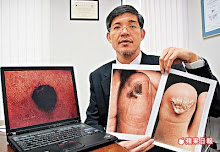
A Breast Cancer Cell
Age and Physical Risk Factors in Breast Cancer by Mai Brooks MD
Age is likely the most important overall factor associated with breast cancer risk. Breast cancer risk increases in the older post-menopausal population. For this reason, all breast cancer screening recommendations are based primarily on age. Obesity, however, may be the single most preventable risk factor associated with breast cancer. With the dramatic increase in obesity in the U.S., this may be the number one reason for a persistently high incidence in breast cancer. Other physical factors also play some roles in breast cancer risk. These include height, body shape, breast size, and mammographic density. These physical factors are summarized below. Body Weight and Breast Cancer: A woman's body weight does affect her risk of breast cancer but the effect is different for premenopausal and postmenopausal breast cancer. Most studies have found that heavier women (weighing more than 175 pounds) have a lower risk of breast cancer before menopause and higher risk of breast cancer after menopause, compared to thinner women (weighing less than 130 pounds). Since 80% of breast cancers occur after menopause, the negative effects of obesity far outweigh the beneficial effects. The results are the same whether body weight is examined directly or if body mass index is used to adjust for the effects of height on body weight. Body Shape and Breast Cancer: Several human studies have found that women who carry more of their body fat on their stomach (apple shaped) have higher rates of postmenopausal breast cancer compared to women with more of their body fat around their hips (pear shaped). This seems to be true regardless of women's body weight. The relationship of the location of fat on the body and premenopausal breast cancer risk has not been clearly determined Height and Breast Cancer: A woman's height has been associated with breast cancer risk in many studies. Taller women (5' 9" or taller) have a small increase in risk of both premenopausal and postmenopausal breast cancer compared to shorter women (5' 3" or shorter). A person's height is determined by the interaction of genetics and nutrition. How height might affect breast cancer risk is unclear. Breast Size and Breast Cancer: There is a popular belief that small breasts are at lower risk of breast cancer. This theory has been used to explain why women with breast implants have a smaller risk of breast cancer. However, most studies have found no association between breast size and breast cancer risk. One study, however, did find an increase in the risk of breast cancer among lean women with larger breasts. In this study, more than 4,000 women were grouped according to their bra size before childbirth. Women who were lean (chest size less than 34 inches) and had larger breasts (size B, C or larger cups) were at higher risk of post menopausal breast cancer relative to women of the same chest size with an A or smaller cup size. Women with other chest sizes had no association between breast cup size and breast cancer risk. More studies are needed to confirm these results Mammographic density: Numerous epidemiological studies have shown that breast density as measured on mammograms is a significant risk factor for breast cancer. The risk of breast cancer associated with the highest category of density has been estimated to be much greater than in the lowest density category. Mammographic density appears to be predictive for developing invasive cancer after DCIS (ductal carcinoma in situ). Increasing density is associated with increasing breast cancer risk in both premenopausal and postmenopausal women, with the effect persisting for ten years after mammography. Mammographic density has also been shown to be a risk factor for breast cancer in women with a family history of the disease. Mammographic density is probably important even in patients who are BRCA gene positive. In fact, mammographic density may actually have a substantial heritable component.
About the Author
Dr. Mai Brooks is a surgical oncologist/general surgeon, with expertise in early detection and prevention of cancer. More at www.drbrooksmd.com, thecancerexperience.wordpress.com and progressreportoncancer.wordpress.com.
Photo credit; http://www.news-medical.net

0 comments:
Post a Comment